
All of these have
been sold, but we're keeping this section
because information about barometers is often hard to find.
|
The trim and black mouldings are solid ebony, and the panel of crotch mahogany down the trunk is of the finest quality. The Roman lettering engraving on the silvered register plates is of the typical 18th century form. The very finely shaped scroll cornice, a style shared with Dollond, Rubergall, and others, is especially graceful with its low scrolls over complex pediment mouldings, and the urn-shaped cistern cover is a classic.
|
|
Succeeding
|
|
English Regency Period
Satinwood This is a large and imposing instrument, made without any compromises in time or expense. The fine satinwood veneers are outlined with ebony and boxwood stringing, and the cornice is accented with ivory paterae. The engraving on the dial and ancillary plates is of the best quality of the period. Note the solar and lunar depictions and the engraved crest at the center of the fine dial. All in working order, including the clock, which is a 30-hour fusée timepiece with verge and balance escapement by watchmaker William Terry of London, numbered 91. The barometer is signed P. Barbon & Co., Fullwood Rents, London. Barbon practiced at this address from approximately 1810 to 1830, the peak years of the Regency period. The watchmaker William Terry is listed by Baillie as "early 19th century." Circa 1820-30 |
|
|
Admiral Fitzroy's Prize
Medal Barometer |
||
|
This is one of the earliest of the Fitzroy type of mercury barometers, all of which were made after Admiral Fitzroy went to that great weather station in the sky in 1865. The top bears the gilded brass crest of the Royal coat of arms of England, and the paper register plates are inscribed Admiral Fitzroy's Prize Medal Barometer. A Registry of Design label for 1868 identifies the maker as Joseph Davis & Co., who started business at 163 Fenchurch Street in London in about 1868, then moved to the Royal Polytechnic Institution in 1870. This barometer may have been modeled after a prize-winning effort at the 1867 Universal Exposition in Paris. Research continues. The case is of oak with a carved oak cresting, with figured ash or elm veneers above and below the printed-paper plates. |
 |
The register plates are of the earliest Fitzroy style also used on Davis' "Royal Polytechnic" barometers produced around the same time. The brass mounted storm bottle has a paper plate just below it describing the actions of the crystals and liquid, and a (restored) Fahrenheit thermometer. The very large mercury tube is original. As is the case with most Fitzroy barometers, the relationship between the mercury tube and the register plates is in error, in this case by about .6 inch, and the barometer reads slightly high at sea level. This may be a deliberate "adjustment" introduced by the maker to allow a wider range of elevations for use of the instrument. Circa 1868-1870 |
| |
Mahogany Barometer by John Russell of Falkirk. One of the best-known clock and watchmakers
of his day, he was named Watchmaker to His Royal Highness
the Prince Regent in 1811. He also produced superb barometers. |
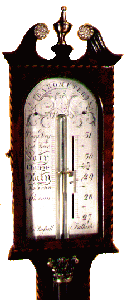 |
|
Turned solid cherry with an acorn finial, this instrument has a straight tube with a cast-iron cistern, a vernier operated by a wire through the top, and a mercury thermometer mounted on the engraved silvered brass plate. Signed C Wilder Peterborough NH it is complete, undamaged, and virtually untouched. Circa 1865. |
A very classic form, this mahogany stick barometer was made about 1825 and signed by P. Richardson, 48 Leadenhall Street, London. It has feather banding down the case, an architectural pediment, and a silvered brass register plate. The top of the tube and the scales are protected by a rectangular glass door, framed with mahogany banding. Replaced cistern cover. Circa 1820-30. |
|
A notable feature of this fine London barometer
is the hygrometer mounted above the register plate, framed
in a panel of mahogany decorated with satinwood. The mahogany
case's moulded edges are bordered with lines of boxwood and
ebony stringing. The silvered brass register plate is nicely
engraved with script and Roman lettering, and is protected
by a framed glass door. 43" x 5" |
The case is solid mahogany carved as a fluted
column and serves as a base for a large boxed marine sympiesometer.
The ivory register plates are engraved with two sets of scales
and have two rack-and-pinion verniers that allow a three-point
trend to be observed. Echoing the carved lobed base, the pediment
is gadrooned and has a low peak. The finial, cistern cover,
gimbal, and ring are all brass. Decorated marine barometers
such as this were commonly used in yachts or homes rather than
on commercial or military ships. |
|
The large red The thermometer notes record high and low temperatures in Paris, Amsterdam, and Greitz in Germany, from 1743 to 1798. Weather indications are naturally Dutch; "Orcaan" (hurricane), "Hevige Storm" (severe storm), "Storm", "Veel Reg. of Wind" (much rain and wind), "Regen of Wind" (rain or wind), "Veranderlyk" (changeable, or variable), "Goed Weer" (good weather), "Mooy Weer" (beautiful weather), "Bestendig" (settled), and "Heel Schoon" (perfect weather). The main weather scale, which one reads off the top of the red oil in the far right tube of the instrument, is confusingly a combination of English inches, from 28 to 31, divided into 36 divisions radiating upward in 20 divisions from about 29.7 inches (median barometric pressure at Amsterdam's latitude) to 31 inches, and downward from 29.7 to 28 in 16 divisions. A small movable pointer traverses this scale. Circa 1810-1830 |
|
Mid-19th Century American ship’s
barometer
Restorations include the hanging ring and the gimbal. The mercury system is a correct replacement. The original French polish finish has been polished and waxed. Smart’s The Makers of Surveying Instruments in America Since 1700 lists the partnership of Abner Lowell and William Senter as practicing from 1846 to 1871 in Portland, selling watches, jewelry and nautical instruments. Lowell is listed until about 1872, then Senter and later his son are listed as practicing 1883. This instrument was made about 1850 to 1860, as indicated by the style of engraving and the use of the dual verniers, a feature that appeared primarily after 1850. Circa 1850-1860 |
|
ADMIRAL ROBERT FITZROY Robert Fitzroy, son of Lord Charles, was born at Ampton
Hall, Suffolk, in 1805 and entered the Navy at the age of 12. During
his long career, he was for many years Captain of the HMS Beagle which
achieved fame as a result of Charles |
Charles Edwin Inc.
Copyright © Charles Edwin Inc. 2011 All Rights Reserved

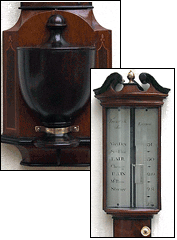




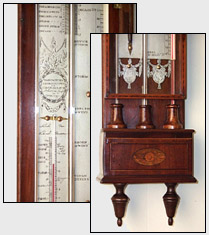 spirit
thermometer is graduated in Fahrenheit and Reaumur. The polished
pewter register plates are profusely engraved and decorated.
The maker is Solari
& Co., Groningen, in the northern Netherlands. Contra-barometers,
also known as bak-barometers (literally, barometer
in a box, for the rectangular glass-fronted case), are found
throughout the Low Countries from about 1740 onwards, but
the Dutch used them more than any other country.
spirit
thermometer is graduated in Fahrenheit and Reaumur. The polished
pewter register plates are profusely engraved and decorated.
The maker is Solari
& Co., Groningen, in the northern Netherlands. Contra-barometers,
also known as bak-barometers (literally, barometer
in a box, for the rectangular glass-fronted case), are found
throughout the Low Countries from about 1740 onwards, but
the Dutch used them more than any other country.  American-made
marine barometers are rare. Most 19th century American ships’ outfitters
imported English barometers with the English makers’ or
American sellers’ names on them, but this particular instrument
is all American in origin.
American-made
marine barometers are rare. Most 19th century American ships’ outfitters
imported English barometers with the English makers’ or
American sellers’ names on them, but this particular instrument
is all American in origin. 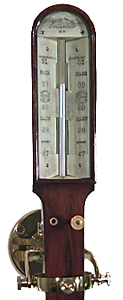 The
sharply tapered case is veneered with rosewood over poplar
secondary wood, with some pine fittings behind the ivory register
plates. Portland on the signature plate is spelled Poartland.
There are two verniers, one each for Yesterday and Today, operated
by the single set knob. While most marine barometers have a
hanging ring mounted on a brass plate on the curved top of
the case, this barometer uses a brass plate on the back with
a hanging ring. The Fahrenheit
The
sharply tapered case is veneered with rosewood over poplar
secondary wood, with some pine fittings behind the ivory register
plates. Portland on the signature plate is spelled Poartland.
There are two verniers, one each for Yesterday and Today, operated
by the single set knob. While most marine barometers have a
hanging ring mounted on a brass plate on the curved top of
the case, this barometer uses a brass plate on the back with
a hanging ring. The Fahrenheit 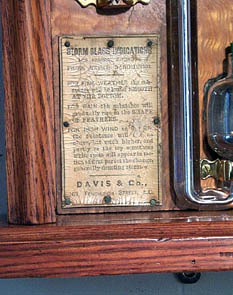 At his retirement from active service in 1850, he
turned his attention to the science of meteorology.
Among his considerable accomplishments, he induced
the Times to print weather information on a daily basis and
the Board of Trade to supply many coastal villages with barometers. He
designed a vastly improved marine barometer. In 1862 he published his
Weather Book which summarized his extensive and immensely important work
on meteorology.
At his retirement from active service in 1850, he
turned his attention to the science of meteorology.
Among his considerable accomplishments, he induced
the Times to print weather information on a daily basis and
the Board of Trade to supply many coastal villages with barometers. He
designed a vastly improved marine barometer. In 1862 he published his
Weather Book which summarized his extensive and immensely important work
on meteorology.